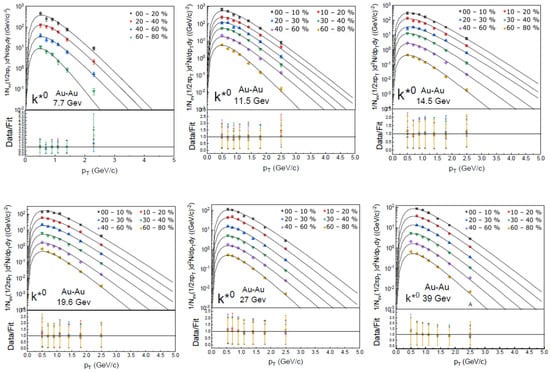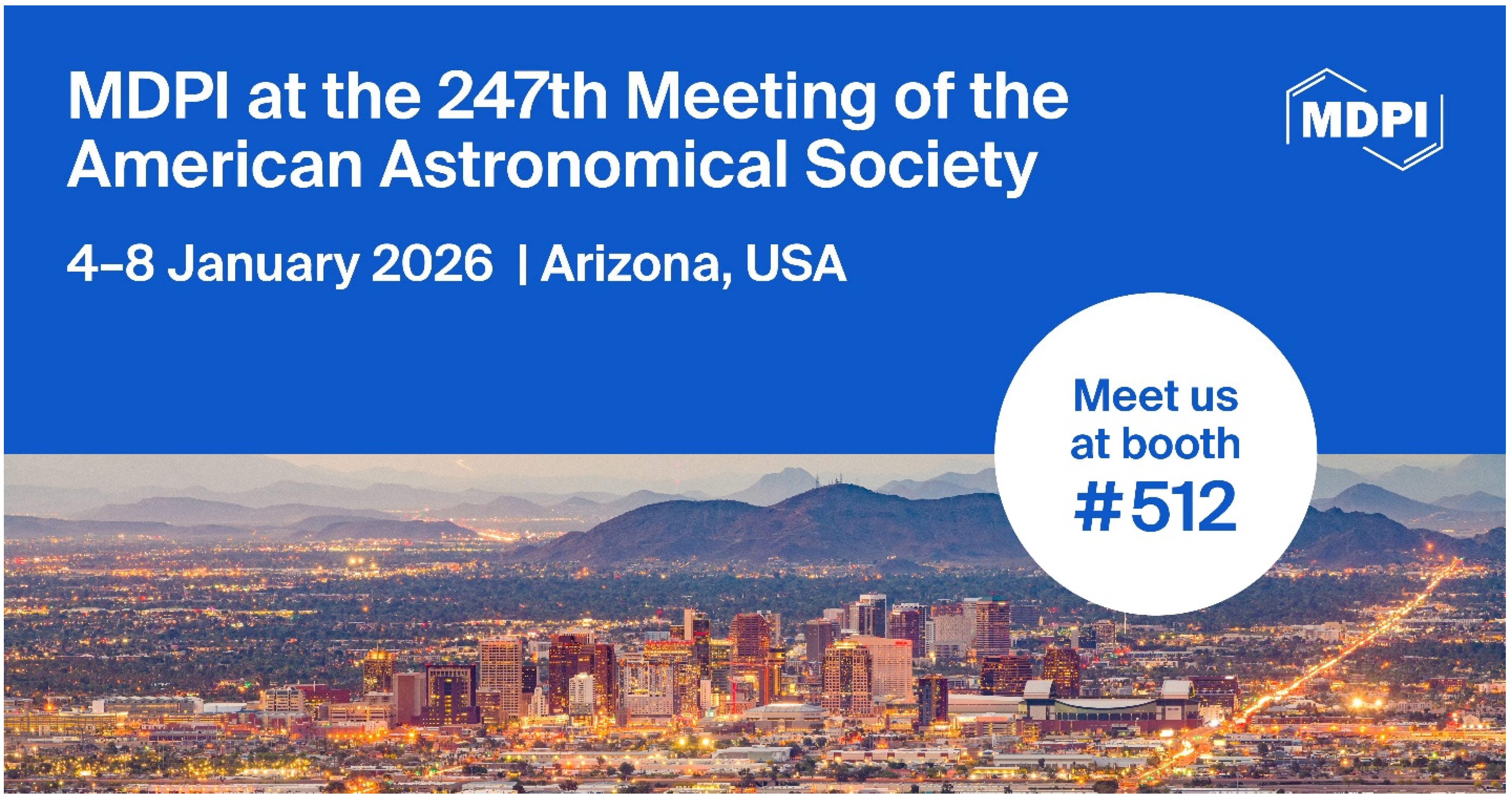Journal Description
Particles
Particles
is an international, open access, peer-reviewed journal covering all aspects of nuclear physics, particle physics and astrophysics science, and is published quarterly online by MDPI.
- Open Access— free for readers, with article processing charges (APC) paid by authors or their institutions.
- High Visibility: indexed within Scopus, ESCI (Web of Science), Inspec, CAPlus / SciFinder, and other databases.
- Journal Rank: JCR - Q2 (Astronomy and Astrophysics) / CiteScore - Q2 (Nuclear and High Energy Physics)
- Rapid Publication: manuscripts are peer-reviewed and a first decision is provided to authors approximately 23.8 days after submission; acceptance to publication is undertaken in 4.7 days (median values for papers published in this journal in the first half of 2025).
- Recognition of Reviewers: reviewers who provide timely, thorough peer-review reports receive vouchers entitling them to a discount on the APC of their next publication in any MDPI journal, in appreciation of the work done.
Impact Factor:
2.3 (2024);
5-Year Impact Factor:
1.8 (2024)
Latest Articles
Insights into the Temperature Parameters from K*0 Spectrum in Nuclear Particle Collisions at the Relativistic High-Energy Collider Beam Energies
Particles 2025, 8(4), 103; https://doi.org/10.3390/particles8040103 - 15 Dec 2025
Abstract
The blast-wave model with Boltzmann–Gibbs statistics is used to examine the transverse momentum spectra of
The blast-wave model with Boltzmann–Gibbs statistics is used to examine the transverse momentum spectra of
(This article belongs to the Special Issue Advances in QCD: Bridging Heavy-Ion Collisions and Electron Scattering at the Electron-Ion Collider)
►
Show Figures
Open AccessPerspective
Onboard Machine Learning for High-Energy Observatories for Spacecraft Autonomy and Ground Segment Operations
by
Andrea Bulgarelli, Luca Castaldini, Nicolò Parmiggiani, Ambra Di Piano, Riccardo Falco, Alessio Aboudan, Lorenzo Amati, Andrea Argan, Paolo Calabretto, Mauro Dadina, Adriano De Rosa, Valentina Fioretti, Claudio Labanti, Giulia Mattioli, Gabriele Panebianco, Carlotta Pittori, Alessandro Rizzo, Smiriti Srivastava and Enrico Virgilli
Particles 2025, 8(4), 102; https://doi.org/10.3390/particles8040102 - 12 Dec 2025
Abstract
Next-generation space observatories for high-energy gamma-ray astrophysics will increase scientific return using onboard machine learning (ML). This is now possible thanks to today’s low-power, radiation-tolerant processors and artificial intelligence accelerators. This paper provides an overview of current and future ML applications in gamma-ray
[...] Read more.
Next-generation space observatories for high-energy gamma-ray astrophysics will increase scientific return using onboard machine learning (ML). This is now possible thanks to today’s low-power, radiation-tolerant processors and artificial intelligence accelerators. This paper provides an overview of current and future ML applications in gamma-ray space missions focused on high-energy transient phenomena. We discuss onboard ML use cases that will be implemented in the future, including real-time event detection and classification (e.g., gamma-ray bursts), and autonomous decision-making, such as rapid repointing to transient events or optimising instrument configuration based on the scientific target or environmental conditions.
Full article
(This article belongs to the Special Issue Advances in Space AstroParticle Physics: Frontier Technologies for Particle Measurements in Space, 2025 Edition)
►▼
Show Figures

Figure 1
Open AccessArticle
The EPSI R&D: Development of an Innovative Electron–Positron Discrimination Technique for Space Applications
by
Oscar Adriani, Lucia Baldesi, Eugenio Berti, Pietro Betti, Massimo Bongi, Alberto Camaiani, Massimo Chiari, Raffaello D’Alessandro, Giacomo De Giorgi, Noemi Finetti, Leonardo Forcieri, Elena Gensini, Andrea Paccagnella, Lorenzo Pacini, Paolo Papini, Oleksandr Starodubtsev, Anna Vinattieri and Chiara Volpato
Particles 2025, 8(4), 101; https://doi.org/10.3390/particles8040101 - 12 Dec 2025
Abstract
The study of the antimatter component in cosmic rays is essential for the understanding of their acceleration and propagation mechanisms, and is one of the most powerful tools for the indirect search of dark matter. Current methods rely on magnetic spectrometers for charge-sign
[...] Read more.
The study of the antimatter component in cosmic rays is essential for the understanding of their acceleration and propagation mechanisms, and is one of the most powerful tools for the indirect search of dark matter. Current methods rely on magnetic spectrometers for charge-sign discrimination, but these are not suitable for extending measurements to the TeV region within a short timeframe of a few decades. Since most of present and upcoming high-energy space experiments use large calorimeters, it is crucial to develop an alternative charge-sign discrimination technique that can be integrated with them. The Electron/Positron Space Instrument (EPSI) project, a two-year R&D initiative launched in 2023 with EU recovery funds, aims to address this challenge. The basic idea is to exploit the synchrotron radiation emitted by charged particles moving through Earth’s magnetic field. The simultaneous detection of an electron/positron with an electromagnetic calorimeter and synchrotron photons with an X-ray detector is enough to discriminate between the two particles at the event level. The main challenge is to develop an X-ray detector with a very large active area, high X-ray detection efficiency, and a low-energy detection threshold, compliant with space applications. In this paper, we give an overview of the EPSI project, with a focus on the general idea of the detection principle, the concept of the space instrument, and the design of the X-ray detector.
Full article
(This article belongs to the Special Issue Advances in Space AstroParticle Physics: Frontier Technologies for Particle Measurements in Space, 2025 Edition)
►▼
Show Figures

Figure 1
Open AccessArticle
Neutrino-Pair Bremsstrahlung Due to Electromagnetic Collisions in Neutron Star Cores Revisited
by
Peter S. Shternin
Particles 2025, 8(4), 100; https://doi.org/10.3390/particles8040100 - 11 Dec 2025
Abstract
We reconsider the problem of neutrino-pair bremsstrahlung emission originating from the electromagnetic collisions of charged particles in nucleonic (
We reconsider the problem of neutrino-pair bremsstrahlung emission originating from the electromagnetic collisions of charged particles in nucleonic (
(This article belongs to the Special Issue Infinite and Finite Nuclear Matter (INFINUM))
►▼
Show Figures
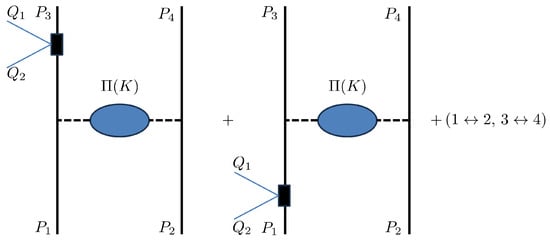
Figure 1
Open AccessArticle
Pattern Recognition with Artificial Intelligence in Space Experiments
by
Federica Cuna, Maria Bossa, Fabio Gargano and Mario Nicola Mazziotta
Particles 2025, 8(4), 99; https://doi.org/10.3390/particles8040099 - 10 Dec 2025
Abstract
The application of advanced Artificial Intelligence (AI) techniques in astroparticle experiments represents a major advancement in both data analysis and experimental design. As space missions become increasingly complex, integrating AI tools is essential for optimizing system performance and maximizing scientific return. This study
[...] Read more.
The application of advanced Artificial Intelligence (AI) techniques in astroparticle experiments represents a major advancement in both data analysis and experimental design. As space missions become increasingly complex, integrating AI tools is essential for optimizing system performance and maximizing scientific return. This study explores the use of Graph Neural Networks (GNNs) within the tracking systems of space-based experiments. A key challenge in track reconstruction is the high level of noise, primarily due to backscattering tracks, which can obscure the identification of primary particle trajectories. We propose a novel GNN-based approach for node-level classification tasks, specifically designed to distinguish primary tracks from backscattered ones within the tracker. In this framework, AI is employed as a powerful tool for pattern recognition, enabling the system to identify meaningful structures within complex tracking data and to discriminate signal from backscattering with higher precision. By addressing these challenges, our work aims to enhance the accuracy and reliability of data interpretation in astroparticle physics through the advanced deep learning techniques.
Full article
(This article belongs to the Special Issue Advances in Space AstroParticle Physics: Frontier Technologies for Particle Measurements in Space, 2025 Edition)
►▼
Show Figures
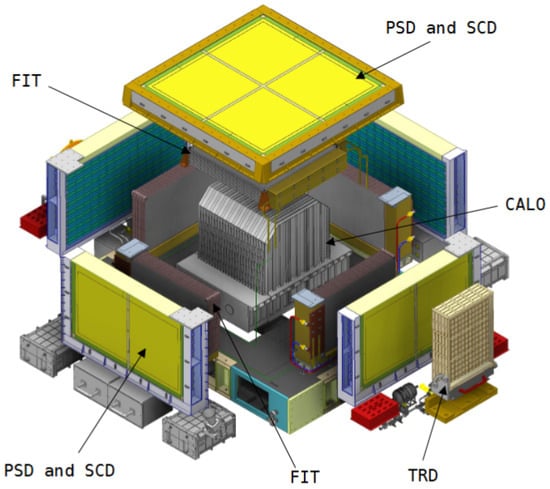
Figure 1
Open AccessArticle
Magnetic Field Amplification and Reconstruction in Rotating Astrophysical Plasmas: Verifying the Roles of α and β in Dynamo Action
by
Kiwan Park
Particles 2025, 8(4), 98; https://doi.org/10.3390/particles8040098 - 4 Dec 2025
Abstract
We investigate the
We investigate the
(This article belongs to the Special Issue Particles and Plasmas in Strong Fields)
►▼
Show Figures

Figure 1
Open AccessArticle
A Nanosatellite-Sized Detector for Sub-MeV Charged Cosmic Ray Fluxes in Low Earth Orbit: The Low-Energy Module (LEM) Onboard the NUSES Space Mission
by
Riccardo Nicolaidis, Andrea Abba, Domenico Borrelli, Adriano Di Giovanni, Luigi Ferrentino, Giovanni Franchi, Francesco Nozzoli, Giancarlo Pepponi, Lorenzo Perillo, David Schledewitz and Enrico Verroi
Particles 2025, 8(4), 97; https://doi.org/10.3390/particles8040097 - 4 Dec 2025
Abstract
NUSES is a planned space mission aiming to test new observational and technological approaches related to the study of low-energy cosmic rays, gamma rays, and high-energy astrophysical neutrinos. Two scientific payloads will be hosted onboard the NUSES space mission: Terzina and Zirè. Terzina
[...] Read more.
NUSES is a planned space mission aiming to test new observational and technological approaches related to the study of low-energy cosmic rays, gamma rays, and high-energy astrophysical neutrinos. Two scientific payloads will be hosted onboard the NUSES space mission: Terzina and Zirè. Terzina will be an optical telescope readout by SiPM arrays for the detection and study of Cerenkov light emitted by Extensive Air Showers (EASs) generated by high-energy cosmic rays and neutrinos in the atmosphere. Zirè will focus on the detection of protons and electrons up to a few hundred MeV and 0.1–30 MeV photons and will include the Low-Energy Module (LEM). The LEM will be a particle spectrometer devoted to the observation of fluxes of low-energy electrons in the 0.1–7-MeV range and protons in the 3–50 MeV range in low Earth orbit (LEO) followed by the hosting platform. The detection of Particle Bursts (PBs) in this physics channel of interest could provide insights into understanding complex phenomena such as possible correlations between seismic events or volcanic activity with the collective motion of particles in the plasma populating Van Allen belts. With its compact size and limited acceptance, the LEM will allow the exploration of hostile environments such as the South Atlantic Anomaly (SAA) and the inner Van Allen belt, in which the anticipated electron fluxes are on the order of
(This article belongs to the Special Issue Advances in Space AstroParticle Physics: Frontier Technologies for Particle Measurements in Space, 2025 Edition)
►▼
Show Figures
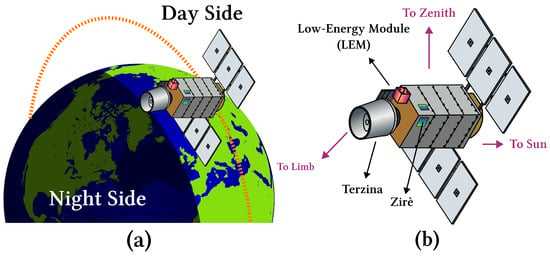
Figure 1
Open AccessArticle
Simulation of a SiPM-Based Cherenkov Camera
by
Isaac Buckland, Riccardo Munini and Valentina Scotti
Particles 2025, 8(4), 96; https://doi.org/10.3390/particles8040096 - 3 Dec 2025
Abstract
Future space detectors for Ultra High Energy neutrinos and cosmic rays will utilize Cherenkov telescopes to detect forward-beamed Cherenkov light produced by charged particles in Extensive Air Showers (EASs). A Cherenkov detector can be equipped with an array of Silicon Photo-Multiplier (SiPM) pixels,
[...] Read more.
Future space detectors for Ultra High Energy neutrinos and cosmic rays will utilize Cherenkov telescopes to detect forward-beamed Cherenkov light produced by charged particles in Extensive Air Showers (EASs). A Cherenkov detector can be equipped with an array of Silicon Photo-Multiplier (SiPM) pixels, which offer several advantages over traditional Photo-Multiplier Tubes (PMTs). SiPMs are compact and lightweight and operate at lower voltages, making them well-suited for space-based experiments. The SiSMUV (SiPM-based Space Monitor for UV-light) is developing a SiPM-based Cherenkov camera for PBR (POEMMA Baloon with Radio) at INFN Napoli. To understand the response of such an instrument, a comprehensive simulation of the response of individual SiPM pixels to incident light is needed. For the accurate simulation of a threshold trigger, this simulation must reproduce the current produced by a SiPM pixel as a function of time. Since a SiPM pixel is made of many individual Avalanche Photo-Diodes (APDs), saturation and pileup in APDs must also be simulated. A Gaussian mixture fit to ADC count spectrum of a SiPM pixel exposed to low levels of laser light at INFN Napoli shows a significant amount of samples between the expected PE (Photo Electron) peaks. Thus, noise sources such as dark counts and afterpulses, which result in partially integrated APD pulses, must be accounted for. With static, reasonable values for noise rates, the simulation chain presented in this work uses the characteristics of individual APDs to produce the aggregate current produced by a SiPM pixel. When many such pulses are simulated and integrated, the ADC spectra generated by low levels of laser light at the INFN Napoli SiSMUV test setup can be accurately reproduced.
Full article
(This article belongs to the Special Issue Advances in Space AstroParticle Physics: Frontier Technologies for Particle Measurements in Space, 2025 Edition)
►▼
Show Figures

Figure 1
Open AccessArticle
Discovering the Underlying Analytic Structure Within Standard Model Constants Using Artificial Intelligence
by
Sergei V. Chekanov and Håkan Kjellerstrand
Particles 2025, 8(4), 95; https://doi.org/10.3390/particles8040095 - 29 Nov 2025
Abstract
This paper presents a method for uncovering hidden analytic relationships among the fundamental parameters of the Standard Model (SM), a foundational theory in physics that describes the fundamental particles and their interactions, using symbolic regression and genetic programming. Using this approach, we identify
[...] Read more.
This paper presents a method for uncovering hidden analytic relationships among the fundamental parameters of the Standard Model (SM), a foundational theory in physics that describes the fundamental particles and their interactions, using symbolic regression and genetic programming. Using this approach, we identify the simplest analytic relationships connecting pairs of these constants and report several notable expressions obtained with relative precision better than 1%. These results may serve as valuable inputs for model builders and artificial intelligence methods aimed at uncovering hidden patterns among the SM constants, or potentially used as building blocks for a deeper underlying law that connects all parameters of the SM through a small set of fundamental constants.
Full article
(This article belongs to the Section Computational and Mathematical Physics, AI and Machine Learning)
►▼
Show Figures
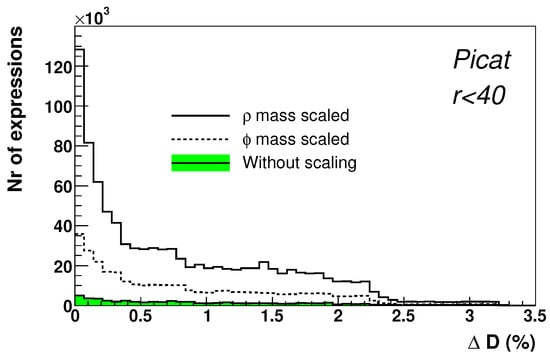
Figure 1
Open AccessArticle
A SiPM-Based RICH Detector with Timing Capabilities for Isotope Identification
by
Mario Nicola Mazziotta, Liliana Congedo, Giuseppe De Robertis, Mario Giliberti, Francesco Licciulli, Antonio Liguori, Leonarda Lorusso, Nicola Nicassio, Giuliana Panzarini and Roberta Pillera
Particles 2025, 8(4), 94; https://doi.org/10.3390/particles8040094 - 28 Nov 2025
Abstract
In this work, we present a novel compact particle identification (PID) detector concept based on Silicon Photomultipliers (SiPMs) optimized to perform combined Ring-Imaging Cherenkov (RICH) and Time-of-Flight (TOF) measurements using a common photodetector layer. The system consists of a Cherenkov radiator layer separated
[...] Read more.
In this work, we present a novel compact particle identification (PID) detector concept based on Silicon Photomultipliers (SiPMs) optimized to perform combined Ring-Imaging Cherenkov (RICH) and Time-of-Flight (TOF) measurements using a common photodetector layer. The system consists of a Cherenkov radiator layer separated from a photosensitive surface equipped with SiPMs by an expansion gap. A thin glass slab, acting as a second Cherenkov radiator, is coupled to the SiPMs to perform Cherenkov-based charged particle timing measurements. We assembled a small-scale prototype instrumented with various Hamamatsu SiPM array sensors with pixel pitches ranging from 2 to 3 mm and coupled with 1 mm thick fused silica window. The RICH radiator consisted of a 2 cm thick aerogel tile with a refractive index of 1.03 at 400 nm. The prototype was successfully tested in beam test campaigns at the CERN PS T10 beam line with pions and protons. We measured a single-hit angular resolution of about 4 mrad at the Cherenkov angle saturation value and a time resolution better than 50 ps RMS for charged particles with Z = 1. The present technology makes the proposed SiPM-based PID system particularly attractive for space applications due to the limited detector volumes available. In this work, we present beam test results obtained with the detector prototype and we discuss possible configurations optimized for the identification of ions in space applications.
Full article
(This article belongs to the Special Issue Advances in Space AstroParticle Physics: Frontier Technologies for Particle Measurements in Space, 2025 Edition)
►▼
Show Figures

Figure 1
Open AccessArticle
The Scintillating Fiber Tracker of the Ziré Detector Onboard the NUSES Space Mission
by
Felicia Carla Tiziana Barbato, Ivan De Mitri, Giuseppe De Robertis, Adriano Di Giovanni, Leonardo Di Venere, Giulio Fontanella, Fabio Gargano, Mario Giliberti, Francesco Licciulli, Antonio Liguori, Francesco Loparco, Leonarda Lorusso, Mario Nicola Mazziotta, Giuliana Panzarini, Roberta Pillera, Pierpaolo Savina and Aleksei Smirnov
Particles 2025, 8(4), 93; https://doi.org/10.3390/particles8040093 - 28 Nov 2025
Abstract
NUSES is a pathfinder satellite that will be deployed in a low Earth orbit, designed with new technologies for space-based detectors. Ziré is one of the payloads of NUSES and aims to measure the spectra of electrons, protons, and light nuclei in a
[...] Read more.
NUSES is a pathfinder satellite that will be deployed in a low Earth orbit, designed with new technologies for space-based detectors. Ziré is one of the payloads of NUSES and aims to measure the spectra of electrons, protons, and light nuclei in a kinetic energy range spanning from a few MeVs to several hundred MeVs, as well as photons in the energy range from 0.1 MeV to 30 MeV. Ziré consists of a Fiber TracKer (FTK), a Plastic Scintillator Tower (PST), a calorimeter (CALOg), an AntiCoincidence System (ACS) and a Low Energy Module (LEM). The FTK is based on thin scintillating fibers read out by Silicon Photomultiplier (SiPM) arrays. We assembled a prototype of Ziré (Zirettino) equipped with a single FTK layer, a reduced number of PST layers and a partially instrumented CALOg. A preliminary version of the Ziré custom Front-End Board (FEB) featuring the on-the-shelf ASIC CITIROC by OMEGA/Weeroc was used for the readout. We carried out several beam test campaigns at CERN’s PS facility and a dynamic qualification test. The performance of FTK will be presented and discussed.
Full article
(This article belongs to the Special Issue Advances in Space AstroParticle Physics: Frontier Technologies for Particle Measurements in Space, 2025 Edition)
►▼
Show Figures

Figure 1
Open AccessArticle
The SiSMUV Project: Development and Characterization of SiPM-Based UV-Light Detectors for Space Telescope Applications
by
Valentina Scotti, Giuseppe Osteria, Marco Mese, Antonio Anastasio, Alfonso Boiano, Isaac Buckland, Vincenzo Masone, Riccardo Munini, Beatrice Panico and Haroon Akhtar Qureshi
Particles 2025, 8(4), 92; https://doi.org/10.3390/particles8040092 - 27 Nov 2025
Abstract
The study of Ultra-High-Energy Cosmic Rays is made possible by space telescopes that allow for the recording of signals generated by Extensive Air Showers (EAS) on the night side of the Earth’s atmosphere. One of the requirements for these telescopes is the detection
[...] Read more.
The study of Ultra-High-Energy Cosmic Rays is made possible by space telescopes that allow for the recording of signals generated by Extensive Air Showers (EAS) on the night side of the Earth’s atmosphere. One of the requirements for these telescopes is the detection of very low photon fluxes, achievable using the latest generation SiPMs characterized by high intrinsic gains, low power consumption, low weight, and robustness against accidental exposure to light. Despite these advantages, some technological issues still need to be addressed, such as the radiation hardness for operation in space. Therefore, the design of a SiPM-based focal surface for UHECR detection must consider the space qualification of SiPM arrays, with the development of compact arrays optimized for low dead-area focal surfaces. SiSMUV (SiPM-based Space Monitor for UV light) is a project dedicated to developing a compact and modular UV detector for use in space telescopes designed to study the fluorescence and Cherenkov signals produced by Ultra-High-Energy Cosmic Rays (UHECRs). Each SiSMUV module incorporates a matrix of SiPMs, a readout ASIC (Radioroc by Weeroc), and an FPGA into a monolithic block. This design enables the acquisition and processing of signals from the sensors. The system can connect to a PC for standalone operation or with back-end electronics for integration into more complex systems. In this paper, we will describe the prototype electronics, the experimental setup and the measurements performed to obtain parameters such as the gain of the SiPMs, and their photon detection efficiency (PDE). We will also present the firmware developed to interface with the readout ASIC and to transmit data to other peripherals.
Full article
(This article belongs to the Special Issue Advances in Space AstroParticle Physics: Frontier Technologies for Particle Measurements in Space, 2025 Edition)
►▼
Show Figures

Figure 1
Open AccessArticle
Advanced Readout Logic for the XGIS Instrument: Discriminating X-Ray and Gamma-Ray Photons from the Background and Particles
by
Paolo Calabretto, Claudio Labanti, Enrico Virgilli, Lorenzo Amati, Riccardo Campana, Giulia Mattioli, Smiriti Srivastava, Ezequiel J. Marchesini, Edoardo Borciani, Ajay Sharma, Giovanni La Rosa, Paolo Nogara, Giuseppe Sottile and Alfonso Pisapia
Particles 2025, 8(4), 91; https://doi.org/10.3390/particles8040091 - 22 Nov 2025
Abstract
The X and Gamma Imager and Spectrometer (XGIS) on board THESEUS is a finely pixelized and modular instrument designed for broadband high-energy transient detection. XGIS consists of two cameras, each composed of 10 supermodules, with each supermodule further divided into 10 modules and
[...] Read more.
The X and Gamma Imager and Spectrometer (XGIS) on board THESEUS is a finely pixelized and modular instrument designed for broadband high-energy transient detection. XGIS consists of two cameras, each composed of 10 supermodules, with each supermodule further divided into 10 modules and each module made with 64 independent readout pixels based on Silicon Drift Detectors coupled with 5 × 5 × 30 mm3 CsI scintillator bars. An algorithm to quickly read out the signals from the 64 pixels and send them in chronological order through the module and supermodule logic up to the camera logic is under development. Furthermore, a challenge for space-based high-energy instruments is distinguishing X-/gamma-ray photons while effectively rejecting background photons and particles, including electrons, protons, and heavier cosmic rays. Unlike traditional systems that rely on anticoincidence systems, XGIS aims to achieve background rejection through an innovative readout logic that analyzes the spatial and temporal properties of energy deposits in the detector. By leveraging the finely pixelized structure, the readout system can differentiate single-photon events from charged-particle tracks based on energy deposition patterns and event topology.
Full article
(This article belongs to the Special Issue Advances in Space AstroParticle Physics: Frontier Technologies for Particle Measurements in Space, 2025 Edition)
►▼
Show Figures
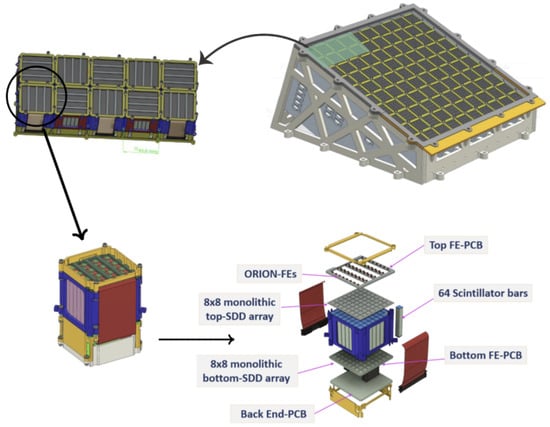
Figure 1
Open AccessArticle
The Cherenkov Camera for the PBR Mission
by
Beatrice Panico, Roberto Ammendola, Antonio Anastasio, Davide Badoni, Mario Bertaina, Francesco Cafagna, Donatella Campana, Marco Casolino, Cristian De Santis, Andrea Di Salvo, Raffaele Gargiulo, Alessandro Marcelli, Laura Marcelli, Vincenzo Masone, Marco Mese, Marco Mignone, Giuseppe Osteria, Giuseppe Passeggio, Francesco Perfetto, Haroon Akhtar Qureshi, Enzo Reali, Ester Ricci and Valentina Scottiadd
Show full author list
remove
Hide full author list
Particles 2025, 8(4), 90; https://doi.org/10.3390/particles8040090 - 21 Nov 2025
Abstract
POEMMA-Balloon with Radio (PBR) is designed as a payload for a NASA suborbital Super Pressure Balloon that will circle over the Southern Ocean and a mission duration as long as 50 days. The PBR instrument consists of a 1.1 m aperture Schmidt telescope
[...] Read more.
POEMMA-Balloon with Radio (PBR) is designed as a payload for a NASA suborbital Super Pressure Balloon that will circle over the Southern Ocean and a mission duration as long as 50 days. The PBR instrument consists of a 1.1 m aperture Schmidt telescope similar to the POEMMA design with two cameras in its focal surface: a Fluorescence Camera (FC) and a Cherenkov Camera (CC). The CC camera is mainly devoted to the observation of cosmic-ray-induced high-altitude horizontal air showers (HAHAs) and search for neutrino-induced upward-going EAS. It will be made of 2048 SiPMs with a surface of 3 × 3 mm2 and a FoV of 12° by 6°, covering a spectral range of 320–900 nm. The CC camera is an innovative detector currently under construction. In this paper, information about its current status will be given.
Full article
(This article belongs to the Special Issue Advances in Space AstroParticle Physics: Frontier Technologies for Particle Measurements in Space, 2025 Edition)
►▼
Show Figures
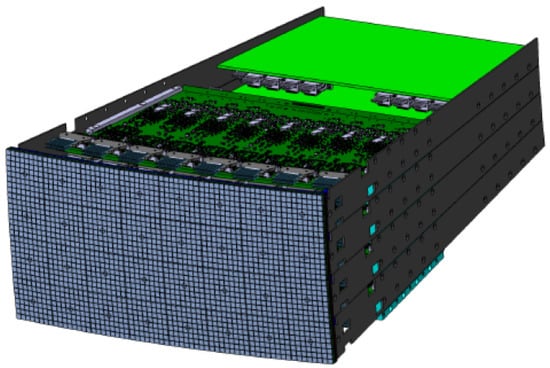
Figure 1
Open AccessArticle
Design of the ANTARES4 Readout ASIC for the Second Flight of the GAPS Experiment: Motivations and Requirements
by
Luca Ghislotti, Paolo Lazzaroni, Massimo Manghisoni and Elisa Riceputi
Particles 2025, 8(4), 89; https://doi.org/10.3390/particles8040089 - 15 Nov 2025
Abstract
The General AntiParticle Spectrometer is a balloon-borne experiment designed to search for low-energy cosmic-ray antinuclei as a potential indirect signature of dark matter. Over the course of at least three long-duration flights over Antarctica, it will explore the sub-
[...] Read more.
The General AntiParticle Spectrometer is a balloon-borne experiment designed to search for low-energy cosmic-ray antinuclei as a potential indirect signature of dark matter. Over the course of at least three long-duration flights over Antarctica, it will explore the sub-
(This article belongs to the Special Issue Advances in Space AstroParticle Physics: Frontier Technologies for Particle Measurements in Space, 2025 Edition)
►▼
Show Figures

Figure 1
Open AccessArticle
Study of the ρ0 Decay into π0π0γ Within Framework of Chiral Perturbation Theory with Resonances
by
José A. Barajas-Aguilar, Francisco V. Flores-Baez and José R. Morones-Ibarra
Particles 2025, 8(4), 88; https://doi.org/10.3390/particles8040088 - 11 Nov 2025
Abstract
In this work, we calculate the Branching Ratio (BR) of the process
In this work, we calculate the Branching Ratio (BR) of the process
(This article belongs to the Section Nuclear and Hadronic Theory)
►▼
Show Figures

Figure 1
Open AccessArticle
Advanced Particle Classification in Space Calorimetry Using Transformer-Based and Gradient Boosting Models
by
Maria Bossa, Federica Cuna and Fabio Gargano
Particles 2025, 8(4), 87; https://doi.org/10.3390/particles8040087 - 5 Nov 2025
Abstract
Artificial intelligence has made remarkable progress across numerous domains, including physics, where machine learning and deep learning methods have become increasingly common. In high-energy physics, these approaches have significantly advanced tasks like event reconstruction, pattern recognition, and large-scale data analysis. The present study
[...] Read more.
Artificial intelligence has made remarkable progress across numerous domains, including physics, where machine learning and deep learning methods have become increasingly common. In high-energy physics, these approaches have significantly advanced tasks like event reconstruction, pattern recognition, and large-scale data analysis. The present study explores the application of machine learning techniques to the classification of electromagnetic and hadronic showers in space calorimeter experiments. Leveraging Monte Carlo simulations and a dedicated feature engineering, the findings demonstrate the strong potential of AI to improve classification performance in space calorimetry.
Full article
(This article belongs to the Special Issue Advances in Space AstroParticle Physics: Frontier Technologies for Particle Measurements in Space, 2025 Edition)
►▼
Show Figures

Figure 1
Open AccessArticle
A Cosmic Radiation Modular Telescope on the Moon: The MoonRay Concept
by
Pier Simone Marrocchesi
Particles 2025, 8(4), 86; https://doi.org/10.3390/particles8040086 - 27 Oct 2025
Abstract
The MoonRay project is carrying out a concept study of a permanent lunar cosmic-ray (CR) and gamma-ray observatory, in view of the implementation of habitats on our satellite. The idea is to build a modular telescope that will be able to overcome the
[...] Read more.
The MoonRay project is carrying out a concept study of a permanent lunar cosmic-ray (CR) and gamma-ray observatory, in view of the implementation of habitats on our satellite. The idea is to build a modular telescope that will be able to overcome the limitations, in available power and weight, of the present generation of CR instruments in Low Earth Orbit, while carrying out high-energy gamma-ray observations from a vantage point at the South Pole of the Moon. An array of fully independent modules (towers), with limited individual size and mass, can provide an acceptance more than one order of magnitude larger than instruments in flight at present. The modular telescope is designed to be deployed progressively, during a series of lunar missions, while collecting meaningful scientific data at the intermediate stages of its implementation. The operational power will be made available by the facilities maintaining the lunar habitats. With a geometric factor close to 15 m2sr and about 8 times larger sensitive area than FERMI-LAT, MoonRay will be able to carry out a very rich observational program over a time span of a few decades with an energy reach of 10 PeV allowing the exploration of the CR “knee” and the observation of the Southern Sky with gamma rays well into the TeV scale. Each tower (of approximate size 20 cm × 20 cm ×100 cm) is equipped with three instruments. A combined Charge and Time-of-Flight detector (CD-ToF) can identify individual cosmic elements, leveraging on an innovative two-layered array of pixelated Low-Gain Avalanche Diode (LGAD) sensors, with sub-ns time resolution. The latter can achieve an unprecedented rejection power against backscattered radiation from the calorimeter. It is followed by a tracker, providing also photon conversion, and by a thick crystal calorimeter (55 radiation lengths, 3 proton interaction lengths at normal incidence) with an energy resolution of 30–40% (1–2%) for protons (electrons) and a proton/electron rejection in excess of 105. A time resolution close to 100 ps has been obtained, with prototypal arrays of 3 mm × 3 mm LGAD pixels, in a recent test campaign carried out at CERN with Pb beam fragments.
Full article
(This article belongs to the Special Issue Advances in Space AstroParticle Physics: Frontier Technologies for Particle Measurements in Space, 2025 Edition)
►▼
Show Figures

Figure 1
Open AccessArticle
The Kaon Off-Shell Generalized Parton Distributions and Transverse Momentum Dependent Parton Distributions
by
Jin-Li Zhang
Particles 2025, 8(4), 85; https://doi.org/10.3390/particles8040085 - 25 Oct 2025
Abstract
We investigate the off-shell generalized parton distributions (GPDs) and transverse momentum dependent parton distributions (TMDs) of kaons within the framework of the Nambu–Jona-Lasinio model, employing proper time regularization. Compared to the pion case, the off-shell effects in kaons are of similar magnitude, modifying
[...] Read more.
We investigate the off-shell generalized parton distributions (GPDs) and transverse momentum dependent parton distributions (TMDs) of kaons within the framework of the Nambu–Jona-Lasinio model, employing proper time regularization. Compared to the pion case, the off-shell effects in kaons are of similar magnitude, modifying the GPDs by about 10–
(This article belongs to the Special Issue Strong QCD and Hadron Structure)
►▼
Show Figures

Figure 1
Open AccessArticle
Pre-Supernova (Anti)Neutrino Emission Due to Weak-Interaction Reactions with Hot Nuclei
by
Alan A. Dzhioev, Andrey V. Yudin, Natalia V. Dunina-Barkovskaya and Andrey I. Vdovin
Particles 2025, 8(4), 84; https://doi.org/10.3390/particles8040084 - 12 Oct 2025
Abstract
Reliable predictions of (anti)neutrino spectra and luminosities are essential for assessing the feasibility of detecting pre-supernova neutrinos. Using the stellar evolution code MESA, we calculate the (anti)neutrino spectra and luminosities under realistic conditions of temperature, density, and electron fraction. Our study includes (anti)neutrinos
[...] Read more.
Reliable predictions of (anti)neutrino spectra and luminosities are essential for assessing the feasibility of detecting pre-supernova neutrinos. Using the stellar evolution code MESA, we calculate the (anti)neutrino spectra and luminosities under realistic conditions of temperature, density, and electron fraction. Our study includes (anti)neutrinos produced by both thermal processes and nuclear weak-interaction reactions. By comparing the results of the thermal quasiparticle random-phase approximation with the standard technique based on the effective Q-value method, we investigate how thermal effects influence the spectra and luminosities of emitted (anti)neutrinos. Our findings show that a thermodynamically consistent treatment of Gamow–Teller transitions in hot nuclei enhances both the energy luminosity and the average energies of the emitted (anti)neutrinos.
Full article
(This article belongs to the Special Issue Infinite and Finite Nuclear Matter (INFINUM))
►▼
Show Figures

Figure 1
Highly Accessed Articles
Latest Books
E-Mail Alert
News
Topics
Topic in
Symmetry, Galaxies, Universe, Particles, Astronomy
Dark Matter, Dark Energy and Cosmological Anisotropy
Topic Editors: Kazuharu Bamba, Panayiotis Stavrinos, Ivan De MartinoDeadline: 31 December 2026

Conferences
Special Issues
Special Issue in
Particles
Selected Papers from XXVIII Workshop “What Comes Beyond the Standard Models?”: New Trends in Particle Cosmology
Guest Editor: Maxim Y. KhlopovDeadline: 30 December 2025
Special Issue in
Particles
Selected Papers from the 14th International Conference on New Frontiers in Physics (ICNFP 2025)
Guest Editors: Larissa Bravina, Sonia Kabana, Armen SedrakianDeadline: 20 January 2026
Special Issue in
Particles
Particles and Plasmas in Strong Fields
Guest Editors: David Blaschke, Tamás Biró, Ralf SchützholdDeadline: 28 February 2026
Special Issue in
Particles
Selected Papers from the International Symposium Commemorating the 40th Anniversary of Halo Nuclei
Guest Editors: Bing Guo, Baohua Sun, Yingxun Zhang, Pengwei Zhao, Qiang ZhaoDeadline: 28 February 2026
Topical Collections
Topical Collection in
Particles
Dark Matter and New Physics of Hidden Particles
Collection Editors: Valery E. Lyubovitskij, Dmitry V. Kirpichnikov, Alexey S. Zhevlakov


